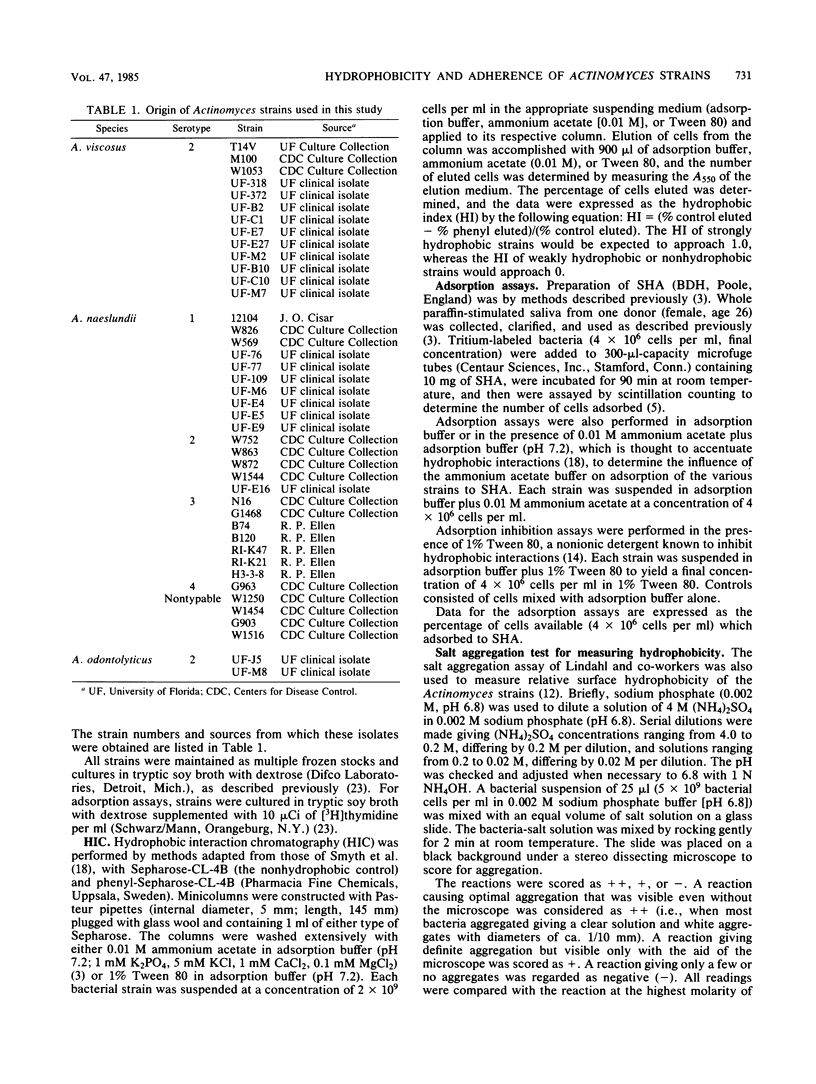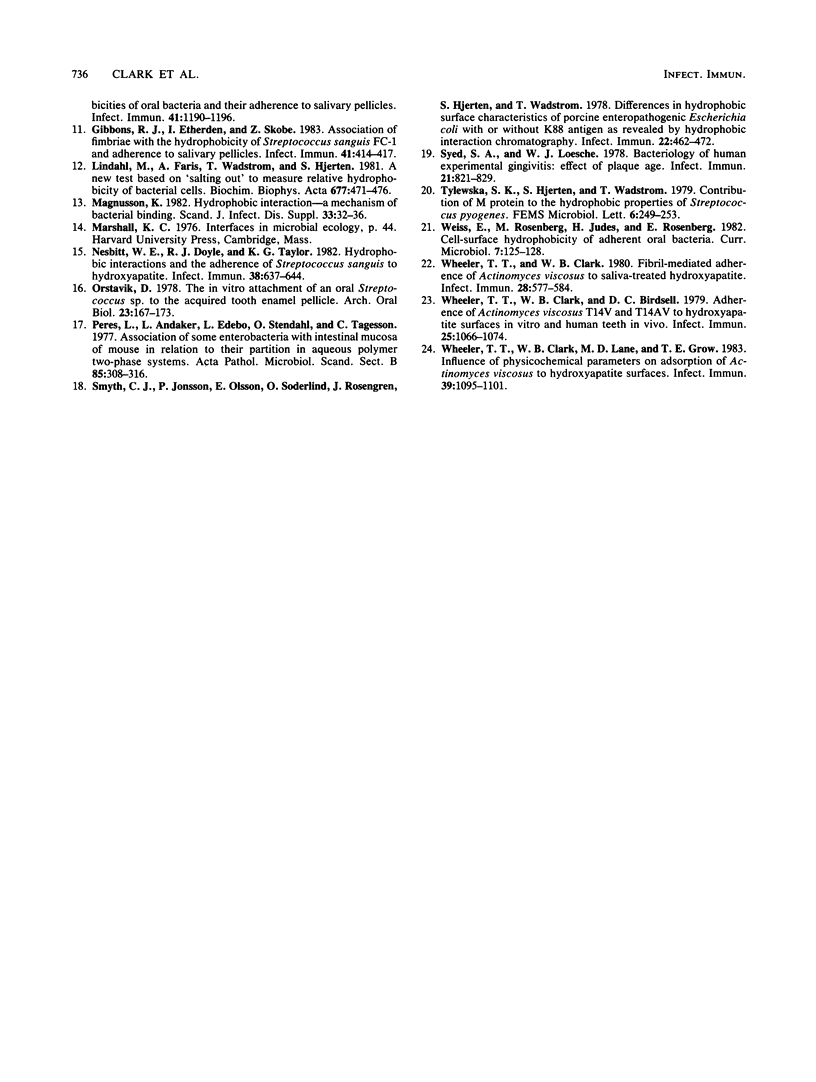Abstract
The present study examined 42 strains of Actinomyces spp. to determine whether adsorption to saliva-treated hydroxyapatite (SHA) of the selected strains of this prominent group of dental-plaque bacteria correlated with hydrophobicity. The relative hydrophobicity of the strains was determined by their adsorption to hydrophobic gels (i.e., phenyl-Sepharose) and their aggregation in ammonium sulfate. Within serogroups the relative hydrophobicity for the strains was similar. The relative adsorption of strains to SHA was also similar within the respective serogroups. Strains which were relatively hydrophobic, as judged by their binding to the hydrophobic gel and aggregation in low concentrations of ammonium sulfate, adsorbed well to SHA. Strains which adsorbed poorly to SHA were relatively hydrophilic since they did not bind well to the hydrophobic gel and were only aggregated in relatively high concentrations of ammonium sulfate. Tween 80, a nonionic detergent known to inhibit hydrophobic interactions, blocked binding of cells to the hydrophobic gel, suggesting that hydrophobic interactions had been inhibited. However, Tween 80 exhibited no influence on the adsorption of cells to SHA. Thus, although there was a strong statistical correlation between the relative hydrophobicity of a strain and its adsorption to SHA, the data were consistent with the view that other interactions, such as ionic bonds and interactions between complimentary macromolecules, are involved in adsorption of the Actinomyces strains to SHA.
Full text
PDF






Selected References
These references are in PubMed. This may not be the complete list of references from this article.
- Cisar J. O., David V. A., Curl S. H., Vatter A. E. Exclusive presence of lactose-sensitive fimbriae on a typical strain (WVU45) of Actinomyces naeslundii. Infect Immun. 1984 Nov;46(2):453–458. doi: 10.1128/iai.46.2.453-458.1984. [DOI] [PMC free article] [PubMed] [Google Scholar]
- Clark W. B., Bammann L. L., Gibbons R. J. Comparative estimates of bacterial affinities and adsorption sites on hydroxyapatite surfaces. Infect Immun. 1978 Mar;19(3):846–853. doi: 10.1128/iai.19.3.846-853.1978. [DOI] [PMC free article] [PubMed] [Google Scholar]
- Clark W. B., Webb E. L., Wheeler T. T., Fischlschweiger W., Birdsell D. C., Mansheim B. J. Role of surface fimbriae (fibrils) in the adsorption of Actinomyces species to saliva-treated hydroxyapatite surfaces. Infect Immun. 1981 Sep;33(3):908–917. doi: 10.1128/iai.33.3.908-917.1981. [DOI] [PMC free article] [PubMed] [Google Scholar]
- Clark W. B., Wheeler T. T., Cisar J. O. Specific inhibition of adsorption of Actinomyces viscosus T14V to saliva-treated hydroxyapatite by antibody against type 1 fimbriae. Infect Immun. 1984 Feb;43(2):497–501. doi: 10.1128/iai.43.2.497-501.1984. [DOI] [PMC free article] [PubMed] [Google Scholar]
- Fillery E. D., Bowden G. H., Hardie J. M. A comparison of strains of bacteria designated Actinomyces viscosus and Actinomyces naeslundii. Caries Res. 1978;12(6):299–312. doi: 10.1159/000260349. [DOI] [PubMed] [Google Scholar]
- Gibbons R. J., Etherden I., Skobe Z. Association of fimbriae with the hydrophobicity of Streptococcus sanguis FC-1 and adherence to salivary pellicles. Infect Immun. 1983 Jul;41(1):414–417. doi: 10.1128/iai.41.1.414-417.1983. [DOI] [PMC free article] [PubMed] [Google Scholar]
- Lindahl M., Faris A., Wadström T., Hjertén S. A new test based on 'salting out' to measure relative surface hydrophobicity of bacterial cells. Biochim Biophys Acta. 1981 Nov 5;677(3-4):471–476. doi: 10.1016/0304-4165(81)90261-0. [DOI] [PubMed] [Google Scholar]
- Magnusson K. E. Hydrophobic interaction--a mechanism of bacterial binding. Scand J Infect Dis Suppl. 1982;33:32–36. [PubMed] [Google Scholar]
- Nesbitt W. E., Doyle R. J., Taylor K. G. Hydrophobic interactions and the adherence of Streptococcus sanguis to hydroxylapatite. Infect Immun. 1982 Nov;38(2):637–644. doi: 10.1128/iai.38.2.637-644.1982. [DOI] [PMC free article] [PubMed] [Google Scholar]
- Orstavik D. The in-vitro attachment of an oral Streptococcus sp. to the acquired tooth enamel pellicle. Arch Oral Biol. 1978;23(3):167–173. doi: 10.1016/0003-9969(78)90212-1. [DOI] [PubMed] [Google Scholar]
- Perers L., Andåker L., Edebo L., Stendahl O., Tagesson C. Association of some enterobacteria with the intestinal mucosa of mouse in relation to their partition in aqueous polymer two-phase systems. Acta Pathol Microbiol Scand B. 1977 Oct;85B(5):308–316. doi: 10.1111/j.1699-0463.1977.tb01980.x. [DOI] [PubMed] [Google Scholar]
- Smyth C. J., Jonsson P., Olsson E., Soderlind O., Rosengren J., Hjertén S., Wadström T. Differences in hydrophobic surface characteristics of porcine enteropathogenic Escherichia coli with or without K88 antigen as revealed by hydrophobic interaction chromatography. Infect Immun. 1978 Nov;22(2):462–472. doi: 10.1128/iai.22.2.462-472.1978. [DOI] [PMC free article] [PubMed] [Google Scholar]
- Syed S. A., Loesche W. J. Bacteriology of human experimental gingivitis: effect of plaque age. Infect Immun. 1978 Sep;21(3):821–829. doi: 10.1128/iai.21.3.821-829.1978. [DOI] [PMC free article] [PubMed] [Google Scholar]
- Wheeler T. T., Clark W. B., Birdsell D. C. Adherence of Actinomyces viscosus T14V and T14AV to hydroxyapatite surfaces in vitro and human teeth in vivo. Infect Immun. 1979 Sep;25(3):1066–1074. doi: 10.1128/iai.25.3.1066-1074.1979. [DOI] [PMC free article] [PubMed] [Google Scholar]
- Wheeler T. T., Clark W. B. Fibril-mediated adherence of Actinomyces viscosus to saliva-treated hydroxyapatite. Infect Immun. 1980 May;28(2):577–584. doi: 10.1128/iai.28.2.577-584.1980. [DOI] [PMC free article] [PubMed] [Google Scholar]
- Wheeler T. T., Clark W. B., Lane M. D., Grow T. E. Influence of physicochemical parameters on adsorption of Actinomyces viscosus to hydroxyapatite surfaces. Infect Immun. 1983 Mar;39(3):1095–1101. doi: 10.1128/iai.39.3.1095-1101.1983. [DOI] [PMC free article] [PubMed] [Google Scholar]


